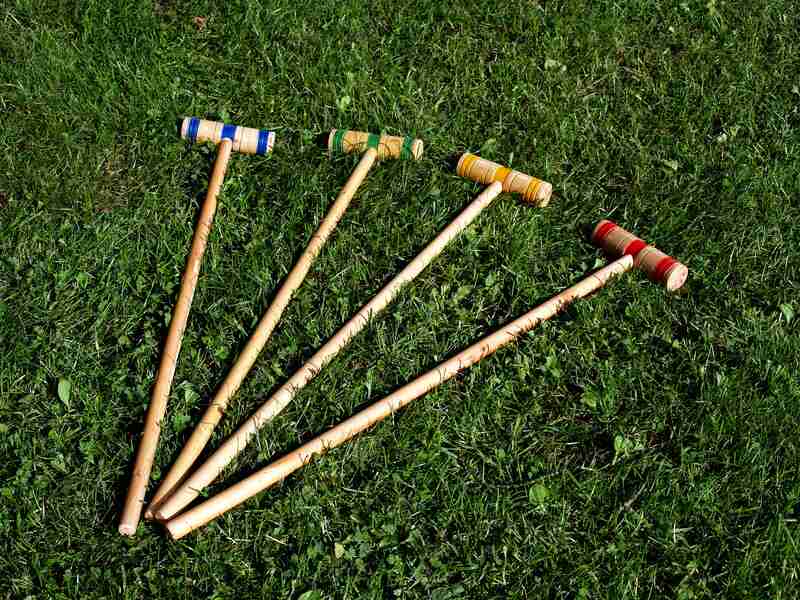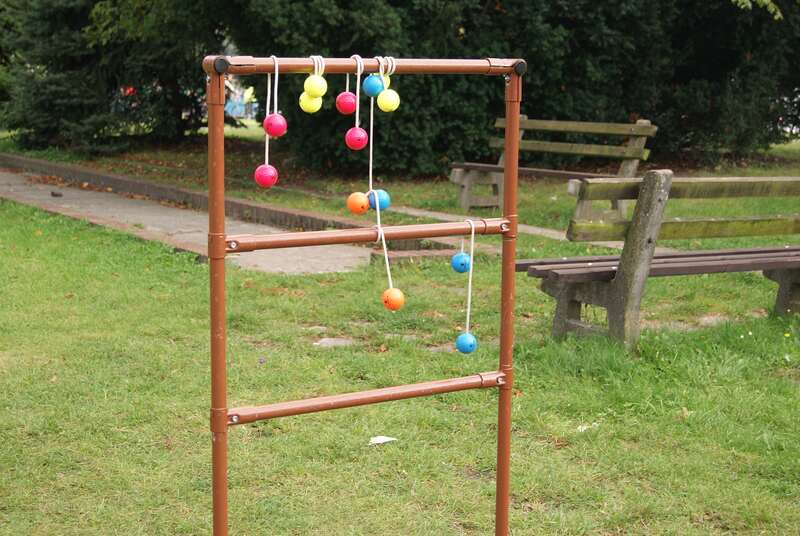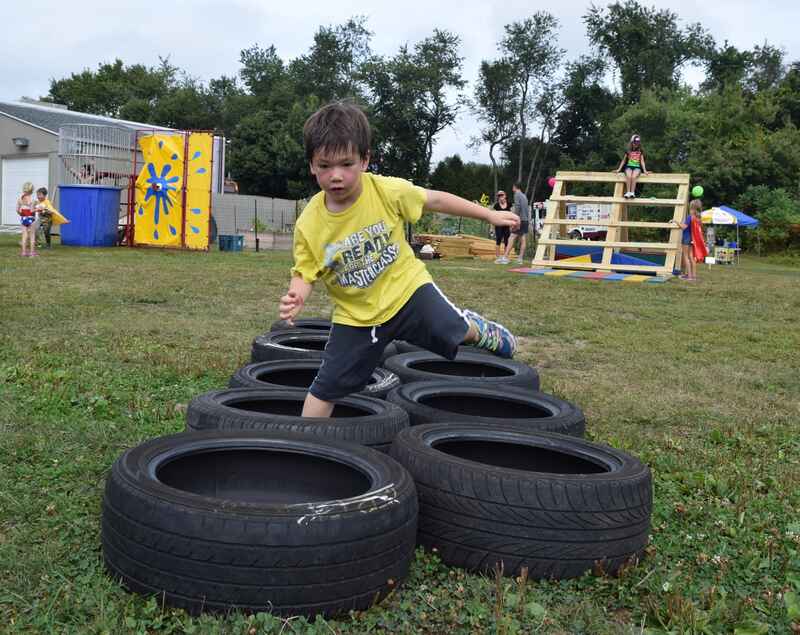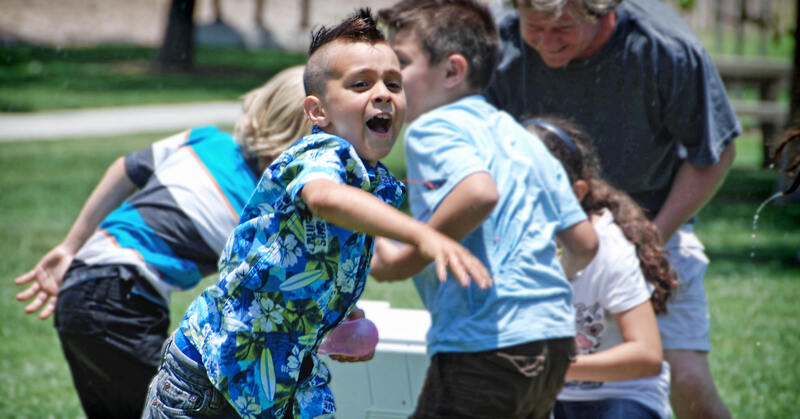
Have you ever felt the yard-time yawn, playing the same game for the hundredth time? We’ve been there. That’s why we’ve dived deep into the world of fun, digging up pickleball and 15 other yard games for kids that will make every backyard moment feel like a new adventure.
Whether you’re planning a lively backyard barbecue, organizing a memorable birthday party, or just aiming for an average day of outdoor fun, these kids’ yard games are sure to be a hit.
- 1. Pickleball
- 2. Cornhole
- 3. Spikeball
- 4. Bocce Ball
- 5. Croquet
- 6. Huge Lawn-Size Games
- 7. Lawn Bowling
- 8. Ladder Toss
- 9. Horseshoes
- 10. Twister
- 11. Obstacle Course
- 12. Scavenger Hunt
- 13. Capture-the-Flag
- 14. Water Balloon Activities
- 15. Red Light, Green Light
- 16. Sidewalk Chalk
- How to Prepare Your Lawn for Yard Games
To ensure everyone enjoys the outdoor fun without any hitches, we’ve also sprinkled in some handy tips to prepare your lawn for yard games.
1. Pickleball

Pickleball has exploded in popularity across the country, quickly earning its place as a top family yard game. It uses small paddles, a low net, and a whiffle ball that won’t hurt if it hits any kid during gameplay.
What makes pickleball a crowd-pleaser? It’s more than a game — it’s a bonding moment. From the energetic little ones to the young-at-heart grandparents, everyone can dive into the fun.
Thinking of pickling in your yard? Getting started is easy. Pickleball sets are available in most local stores and online. And if you’re thinking of leveling up the backyard game, you can even grab a net.
If you want to be the envy of your neighborhood, you can build an asphalt pickleball court right in your backyard. Pickleball court surfaces often are made of asphalt or concrete, and our pricing guides on the cost of concrete by the yard, cost of concrete by the slab, and cost of an asphalt driveway can help you ballpark your costs.
2. Cornhole

Cornhole is a game in which people or teams toss bean bags to a platform across from them, aiming for the hole to score the most points. For the little ones, just bring them a bit closer to the board, and they’ll be tossing and scoring in no time!
Thinking of a larger gathering? Having multiple cornhole sets can create parallel fun — one for the kids and another for the adults. You can even make custom cornhole boards and bean bags for extra fun.
For those looking for some friendly competition, many cities host cornhole leagues or tournaments. So why not elevate your cornhole game from backyard fun to local champion?
Check out our study of the Best Cities for Cornhole Lovers.
3. Spikeball
Spikeball is the go-to game for those looking to mix fast-paced action with minimal equipment. Played with a small net placed at ground level, teams volley a ball, aiming to bounce it off the net in a lively back-and-forth rally.
For the seasoned players, the original Spikeball set offers a two-versus-two format, perfect for older kids and adults. As for the little ones or those just starting out, the Spikeball Rookie Set, with its larger net, caters to younger players or beginners, ensuring everyone gets in on the action.
What’s more, Spikeball is the ultimate space-saver. Unlike volleyball with its towering net, Spikeball centers the game around its ground-level net. This means less space is required, and storage becomes a breeze.
4. Bocce Ball
Bocce an age-old game, involves players or teams taking turns to toss balls, aiming to land them as close as possible to a target ball called the pallino or jack.
Whether you fancy a casual toss on the lawn or want to go all out with a dedicated bocce ball court, the game caters to both moods. A flat, level space will do the trick for those spontaneous matches or for setting up a more permanent court.
However, traditional bocce balls could be difficult for little hands. No need to worry — there is a kid-size bocce ball set with smaller and lighter balls. A bonus with the kid-size bocce ball is that kids can play it inside or outside.
5. Croquet

Using mallets, players in croquet aim to navigate their balls through a series of curved stakes, and each hit brings its own sense of satisfaction.
What makes croquet shine is its universal appeal. It bridges the age gap effortlessly. Kids, adults, grandparents – everyone can join in, making it the perfect game for family gatherings or lazy Sunday afternoons.
Lawns are the popular choice for playing croquet, although it can be played in any flat area in your yard.
6. Huge Lawn-Size Games
Why settle for table-sized fun when you can supersize it? Classic games take on a whole new dimension when played in giant versions on the lawn:
- Jenga: Experience the thrill as towering blocks wobble and tumble.
- Yahtzee: Roll oversized dice and chase high scores in the great outdoors.
- Four in a row: Strategize in life-size, aiming for that winning streak.
- Checkers: Hop and capture on a grand scale with larger-than-life pieces.
- Tic-tac-toe: Draw lines, make moves, and aim for three in a row in this lawn-sized classic.
Adults and kids alike will delight in the nostalgia of these games.
7. Lawn Bowling
Ever thought of turning post-party leftovers into a game? Those empty 2-liter plastic soda bottles from your last barbecue can find a new lease of life as bowling pins. And for the ball? A beach ball or any large ball will do the trick.
Taking the DIY route lets you personalize the game. Imagine your unique bowling alley, where pins are painted with vibrant spray paint or adorned with hand-painted designs using acrylics. And here’s the best part: kids can be a part of this creative journey, adding their own artistic touch.
Tip: Don’t forget to add a small number of rocks or sand to your plastic bottles to keep the wind from knocking them over. But don’t add too much; otherwise, your bowling ball won’t knock over your pins.
8. Ladder Toss

Sometimes known as Ladder Golf, Ladder Toss is a vibrant yard game that promises heaps of fun for kids and adults alike. In this game, players face off from opposite ends, aiming to toss a special rope (equipped with golf balls on both ends) onto a ladder. Each successful land on the ladder racks up points for the thrower.
Younger kids may need a helping hand with untangling the ladder balls or tallying up their scores, but that won’t make it any less fun.
For the DIY enthusiasts, you can make your own ladder toss set. With some PVC pipes, golf balls, string, and your favorite paint shades, you can craft a personalized game set to add flair to your backyard fun.
9. Horseshoes
Simple in its essence, Horseshoes is a delight for players of all ages. The goal is to toss your horseshoe and aim to land it closest to the stake.
If you’re hosting a diverse age group, consider varying the horseshoe weights. That way, everyone from the little ones to the grown-ups can join in on this timeless backyard game.
Space constraints? No worries! Horseshoes is versatile enough to fit any yard setup. Whether you have room for full pits, just one, or none at all, a stake or two is all you need to dive into the fun.
10. Twister
Twister is a classic game to play with kids. Bringing it outside to a new environment adds a different level of fun. Opt for putting your Twister game on your lawn for a soft landing when someone gets too twisted up and takes a tumble.
Worried about your Twister mat getting a bit chaotic outdoors? Go the DIY route! Paint your very own Twister board directly onto your lawn. You can craft a personalized game space using spray paints for the circles, stakes, and string to define the play area.
A little heads-up: Make sure the circles aren’t oversized. Too large, and you might end up with a Twister game that’s a stretch too far for the little ones.
11. Obstacle Course

Unlock your kids’ creativity by co-designing a backyard obstacle course. Since younger kids and older kids have different agility levels, you might need to incorporate various difficulty levels.
Incorporate hula hoops or pool noodles as jump-in spots and use cones for weaving runs. Jump ropes are an excellent item to use as a starting point. Get creative with an obstacle course, and don’t forget to have fun!
12. Scavenger Hunt
Turn your backyard into a treasure trove with a scavenger hunt! However, remember the fun lies in tailoring the hunt according to age groups.
For the little explorers:
- Hunt for a leaf or two
- Spot a butterfly in flight
- Find a feather, maybe one that’s just taken flight
- Gaze up and identify a cloud
- Seek a flower or maybe diverse hues of petals
- Listen closely and locate a bird
For the older crowd, make the scavenger hunt more challenging with difficult-to-find items, such as finding three different kinds of leaves or snapping a selfie with someone wearing a college tee.
13. Capture-the-Flag
You can transform everyday items into the centerpiece of fun with Capture-the-Flag. No official flag? No worries. Bandanas, socks, or even T-shirts can do the trick.
To keep the game engaging for everyone, mix and match teams by age and skill. The rules of Capture-the-Flag can be tweaked to fit your yard’s dimensions.
A quick tip: Hiding spots like bushes and trees are favorites for stashing flags. Make sure the younger kids are clued in about the yard’s terrain. It’s always best to pinpoint any prickly bushes or sneaky poison ivy patches ahead of time. (Better yet: Read our guide on How to Get Rid of Poison Ivy before playing any games in your yard.)
14. Water Balloon Activities

Summer means spending all day outside. What better way to stay cool than some fun water balloon games with the kids? Fun yard games with water balloons could include:
- Water balloon toss –– to another person or a target
- Water balloon dodgeball
- Water balloon baseball
Tip: Consider investing in self-sealing water balloons or reusable water balloons. And once the splashing is over, remember to gather up those balloon remnants. Your lawn may love the extra hydration but littered balloon pieces? Not so much.
15. Red Light, Green Light
If you’re after a game that combines action with attentive listening, look no further than Red Light, Green Light. It’s an age-old favorite that can transform any lawn into a bustling arena of playful activity.
One person shouts “Green Light!” for players to dash forward and “Red Light!” to make them freeze. Get caught moving on red? You’re back to the start. You can add a twist by dribbling a soccer ball, making it both fun and a listening challenge.
16. Sidewalk Chalk

The possibilities are endless when you bust out the sidewalk chalk. Maybe you don’t have an enormous tic-tac-toe set, but you could draw out tic-tac-toe on the driveway with sidewalk chalk. Hopscotch is always a fun game to play, too.
And here’s a summer tip: Combine chalk with water guns or balloons for a splashy learning game. Write letters or words and challenge kids to spray the right answer—it’s a wet, fun way to learn!
Beyond games, chalk offers a canvas for young artists, and why not stir up some friendly competition with chalk art contests?
How to Prepare Your Lawn for Yard Games
While engaging in exciting games like pickleball and other backyard games for kids, it’s essential to ensure a safe and comfortable environment. Consider the following steps to maintain an ouch-free yard:
- Pest check: Keep an eye out for potential nuisances like fire ants, mosquitoes, wasps, and chiggers to maintain a bite-free zone.
- Safety first: Outline clear yard safety rules and eliminate any tripping hazards. Stay vigilant about poison ivy patches to ensure they’re kept at bay.
- Cushion for comfort: A well-maintained lawn provides a soft landing for those playful tumbles. Consider overseeding to thicken your turfgrass, aerating for improved grass growth, and regularly watering to avoid stiff or scratchy grass patches.
If your lawn needs some TLC to get it in tip-top shape for your yard games, hire a local LawnStarter lawn care pro so you can focus on prepping the yard game activities and having fun.
Main Image Credit: Latino Life / Canva Pro / License